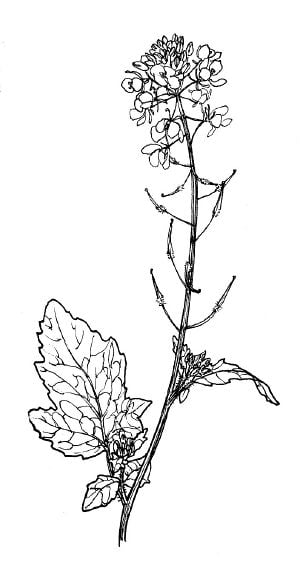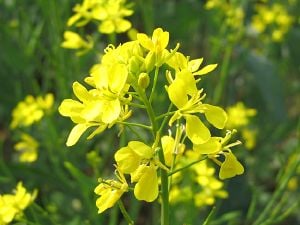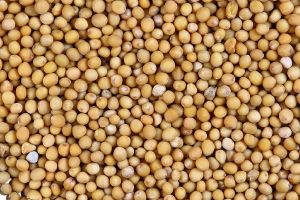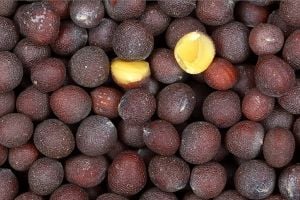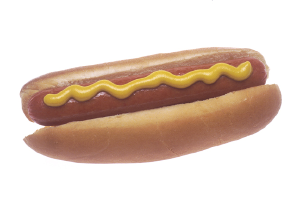Mustard
| Mustard | ||||||||||
|---|---|---|---|---|---|---|---|---|---|---|
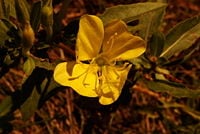 Wild Mustard (Brassica campestris)
| ||||||||||
| Scientific classification | ||||||||||
| ||||||||||
|
See text. |
Mustard is the common name for several herbaceous plants in the genera Brassica and Sinapis of the Brassicaceae family, and in particular Sinapis hirta or Sinapis alba (white or yellow mustard; sometimes classified in Brassica), Brassica juncea (brown or Indian mustard), and Brassica nigra (black mustard), all three of which produce small mustard seeds that can be used as a spice and, by grinding and mixing them with water, vinegar, or other liquids, be turned into a condiment also known as mustard. The seeds are also pressed to make mustard oil, and the edible leaves can be eaten as mustard greens. The term mustard sometimes is used as a collective name for all members of the genus Brassica (a taxon that also includes cabbage, turnip, raddish, and other well-known vegetables), and Brassicaceae is sometimes known as the "mustard family."
Mustard has been called the third most important spice after salt and pepper (Downey 2003). With a use dating to prehistoric times, the plants have been spread by spice traders and conquering armies and have spawned an industry in many nations. The sharp, stimulating flavor of products made from the seeds offers a unique joy to humans, who have used their creativity to develop many varieties to suit different tastes and uses.
The mustard plant: Description and overview
Mustard family
The species of mustard belong to the flowering plant family Brassicaceae (or Cruciferae), also known as the crucifers, the mustard family, or the cabbage family. (Cruciferae is an older name for the family. It means "cross-bearing," because the four petals of their flowers are reminiscent of a cross.)
The family contains species of great economic importance, providing much of the world's winter vegetables. In addition to mustard, these include cabbage, broccoli, cauliflower, brussels sprouts, collards, and kale (all cultivars of one species, Brassica oleracea), Chinese kale, rutabaga (also known as Swedish turnips or swedes), seakale, turnip, radish, and kohl rabi. Other well known members of the Brassicaceae include rapeseed (canola and others), watercress, horseradish, and wasabi.
Brassicaceae consists only of herbaceous plants with annual, biennial, or perennial lifespans. The leaves are alternate (rarely opposite), sometimes organized in basal rosettes. They are very often pinnately incised and do not have stipules.
The structure of the flowers is extremely uniform throughout the family. They have four free saccate sepals and four clawed free petals, staggered. They can be disymmetric or slightly zygomorphic, with a typical cross-like arrangement. They have six stamens, four of which are longer (as long as the petals, so relatively short in fact) and are arranged in a cross like the petals and the other two are shorter (tetradynamous flower). The pistil is made up of two fused carpels and the style is very short, with two lobes. Superior ovary. The flowers form ebracteate racemose inflorescences (floral clustera comprising blossoms attached along a central axis and without underlying bracts), often apically corymb-like (forming a flattish cluster at the top).
Pollination occurs by entomogamy; Nectar is produced at the base of the stamens and stored on the sepals.
Brassicaceae fruit is a peculiar kind of capsule named siliqua (plural siliquae, American English silique/siliques). It opens by two valves, which are the modified carpels, leaving the seeds attached to a framework made up of the placenta and tissue from the junction between the valves (replum). There is often an indehiscent beak at the top of the style and one or more seeds may be borne there. Where a siliqua is less than three times as long as it is broad, it is usually termed a silicula. The siliqua may break apart at constrictions occurring between the segments of the seeds, thus forming a sort of loment (for example, Raphanus); it may eject the seeds explosively (for example, Cardamine); or may be evolved in a sort of samara (for example, Isatis). Unsurprisingly, the fruit is often the most important diagnostic character for plants in this family.
Mustard genera
Brassica is one of the genera to which mustard belongs. The members of the genus may be collectively known either as cabbages, or as mustards. This genus is remarkable for containing more important agricultural and horticultural crops than any other genus. It includes over 30 wild species and hybrids, and numerous additional cultivars and hybrids of cultivated origin. In addition to the mustards, the genus Brassica also includes cabbages, cauliflower, rapeseed, Brussels sprouts, and turnips, among others. Most members of the genus are annuals or biennials, but some are small shrubs. The genus is native in the wild in western Europe, the Mediterranean, and temperate regions of Asia. In addition to the cultivated species, which are grown worldwide, many of the wild species grow as weeds, especially in North America, South America, and Australia.
Species of Brassica include several with the name mustard as part of their common name:
- B. carinata—Abyssinian Mustard or Abyssinian Cabbage
- B. elongata—Elongated Mustard
- B. juncea—Indian Mustard, Brown and leaf mustards, Sarepta Mustard.
- B. narinosa—Broadbeaked Mustard
- B. nigra—Black Mustard
- B. perviridis—Tender Green, Mustard Spinach
- B. rupestris—Brown Mustard
- B. tournefortii—Asian Mustard
Sinapis is another genus of plants in the family Brassicaceae, one of whose species, Sinapis hirta or Sinapis alba is known as the white mustard or yellow mustard. It sometimes is known as Brassica hirta or Brassica alba. Black mustard is sometimes placed in this genus of Sinapis as well, but is more often placed in the related genus Brassica.
An interesting genetic relationship between many species of mustard has been observed, and is described as the Triangle of U.
Three principle mustard species
The three main plants associated with mustard are Sinapis hirta, Brassica juncea, and Brassica nigra.
B. nigra, known as black mustard, is grown in Argentina, Chile, the U.S., and some European countries. it is a tall plant, up to three meters, and sparsely branched (Downey 2003). The dark brown, pungent seeds are very small (1.5 grams per 1,000 seeds) and are shed when the pod matures (Downey 2003). Its seed shedding and dormancy makes it unsuitable for monoculture and mechanized agriculture (Downey 2003), and it has largely been replaced for most purposes by other species because they can be grown and harvested more economically (Herbst 2001).
B. juncea, known as brown or Indian (Oriental) mustard, is originally from the foothills of the Himalaya. It is grown commercially in the United Kingdom, Canada, and the United States. It is shorter (1 to 2 meters in height) than black mustard, has a larger seed (3 grams per 1,000 seeds), and has many upright, heavily podded branches (Downey 2003). Unlike black mustard, brown mustard retains its seeds in the pods after they are ripe, making brown mustard more suitable for mechanized agriculture (Downey 2003). The seed color may be either brown or yellow (Downey 2003). The species is believed to have originated as a natural cross between B. rapa (turnip rape) and B. nigra, followed by chromosome doubling to form a vigorous hybrid (Downey 2003).
S. hirta (or S. alba), known as white or yellow mustard, grows wild in North Africa, the Middle East, and Mediterranean Europe and has spread farther by long cultivation. S. hirta plants are shorter (0.6 meters) than the other two species, have leaves that are deeply lobbed, and the short, hairy pods have five to six seeds, which they also retain when ripe (Downey 2003). This seed is much larger than those of the other two species (6 grams per 1,000 seeds) (Downey 2003). When the ripe seed is moistened, it will exude a viscous fluid from its yellow seed coat that dries to a whitish coating, possibly explaining why its common name in North America is yellow mustard and its common name in Europe is white mustard (Downey 2003). While seeds of B. nigra and B. juncea are considered to have the same pungency, seeds of white mustard are considered to be different in pungency.
Mustard as a condiment
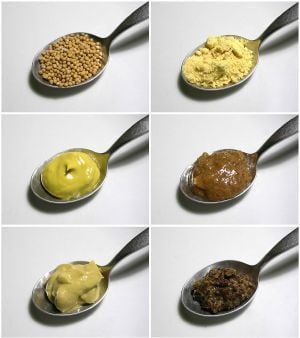
As a condiment, mustard is a thick paste with a sharp, stimulating taste, made from the ground seeds of a mustard plant (white or yellow mustard, Sinapis hirta; brown or Indian mustard, Brassica juncea; or black mustard, Brassica nigra). When the seeds are crushed, elements are released that create an essence that has been described as "fiery" to the taste (McNulty 2002). The crushed seeds may be left in powdered form with the consumer adding water or they may be mixed with water, vinegar, or other liquids, as well as other flavorings and spices. A strong mustard can cause the eyes to water, burn the palate, and inflame the nasal passages. Among the spices that might be added are garlic, tumeric, paprika, and salt, as well as ingredients such as lemon, honey, or horseradish (McNulty 2002).
The important components of the seeds are sulfur compounds called glucosinolates (sinigrin in B. juncea and B. nigra and sinalbin in S. alba), which impart the flavor and pungency (Downey 2003). Stored whole and dry the seeds retain this flavor, but in the presence of moisture and the breaking of the cells of the seed, the enzyme myrosinase (also in the seeds) breaks down the glucosinolates to release sulfur, sugar, and hot principles called isotiocynates (Downey 2003). The yellow mustard releases a milder nonvolatile para-hydroxybenzyl isothiocynate, while seeds of the other two species release the strong, pungent, volatile allyl isothiocynate.
Mustard is most often used as a condiment on meat, especially cold meats. It is also used as an ingredient in mayonnaise and vinaigrette, in marinades and barbecue sauce. It can also be used as a base for salad dressing when combined with vinegar and/or olive oil. Mustard is a popular accompaniment to hot dogs and Bratwurst.
Dry mustard, typically sold in tins, is used in cooking and can be mixed with water to become prepared mustard. Powdered mustard is simply a name for finely ground mustard seed (Herbst 2001).
Prepared mustard is generally sold in glass jars or plastic bottles. Prepared mustard stored for a long period of time is prone to separation, causing mustard water. Shaking the closed jar/bottle prior to opening is recommended.
Varieties
| Mustard, yellow Nutritional value per 100 g | ||||||||||
|---|---|---|---|---|---|---|---|---|---|---|
| Energy 70 kcal 280 kJ | ||||||||||
| ||||||||||
| Percentages are relative to US recommendations for adults. Source: USDA Nutrient database | ||||||||||
There are many varieties of mustard as condiment, which come in a wide range of strengths and flavors. The basic taste and "heat" of the mustard is largely determined by seed type, preparation, and ingredients (Trowbridge 2008). Black seeded mustard is generally regarded as the hottest type. Preparation also plays a key role in the final outcome of the mustard. Mustard, in its powdered form, lacks any potency; it is the production of the isothiocyanates from the reaction of myrosinase and the glucosinolates (sinigrin and sinalbin) that causes heat to be present.
Locations renowned for their mustard include Dijon (medium strength) and Meaux in France; Norwich (very hot) and Tewkesbury, famed for its variety, in the United Kingdom; and Düsseldorf (hot) and Bavaria in Germany. There are variations in the subsidiary spices and in the preparation of the mustard seeds. The husks may be ground with the seeds, or winnowed away after the initial crushing; "whole-grain mustard" retains some unground or partially ground mustard seeds. Bavarian "sweet mustard" contains very little acid, substituting copious amounts of sugar for preservation. Sometimes prepared mustard is simmered to moderate its bite, sometimes it is aged. Irish mustard is a wholegrain type blended with whiskey and or honey.
Dijon mustard
Dijon mustard is not covered by a Protected Designation of Origin (PDO) or a Protected Geographical Indication (PGI) under the auspices of the European Union; thus, while there are major mustard plants in Dijon and suburbs, most Dijon mustard is manufactured outside of Dijon.
Dijon mustard originated in 1856, when Jean Naigeon of Dijon substituted verjuice, the acidic "green" juice of not-quite-ripe grapes, for vinegar in the traditional mustard recipe.
Mustards from Dijon today generally contain both white wine and burgundy wine, and most mustards marketed as Dijon style today contain one or both of these ingredients.
Wholegrain
In wholegrain mustard, the seeds are not ground, but mixed whole with other ingredients. Different flavors and strengths can be achieved by using different blends of mustard seed species. Some variations have additives such as sun-dried tomato mustard and chili mustard.
Honey mustard
Honey mustard, as the name suggests, is a blend of Dijon mustard and honey. It is most often used as a topping for sandwiches and as a side for dipping French fries, onion rings, and other finger foods. It can also be used as a base for salad dressing when combined with vinegar and/or olive oil. The most basic form of honey mustard can be created by combining equal amounts of honey and mustard; however, most varieties incorporate other ingredients to add flavor, adjust texture, or change other properties.
Other uses of mustard plants
All three species of mustard plants can also be used to produce an edible oil, and on the Indian subcontinent, the seeds of B. juncea are used to produce the second most important source of edible vegetable oil (Downey 2003). The plant also is used to produce a high quality protein, and after extraction of this oil, the residual high protein meal can be soaked in water and fed to cattle (Downey 2003).
The leaves of the mustard plants, called mustard greens, are used as food. Furthermore, both the seeds and leaves traditionally have been used for medicinal purposes, including historical use as a curative for the common cold and applications in mustard plasters, baths, and treatments for chilblains (Herbst 2001; Downey 2003).
There has been recent research into varieties of mustards that have a high oil content for use in the production of biodiesel, a renewable liquid fuel similar to diesel fuel. The biodiesel made from mustard oil has good cold flow properties and cetane ratings. The leftover meal after pressing out the oil has also been found to be an effective pesticide.
History
The use of mustard seeds for culinary purpose dates to prehistoric times (McNulty 2002). It is likely that black mustard was the first species harvested as a spice, and its use predates recorded history with planting ready seeds found in a Bronze Age dwelling in Switzerland and in vessels in northwest China dating to 5,000 to 4,000 B.C.E. (Downey 2003). Mustard seeds are mentioned in the Bible; they were cultivated in Palestine, from where they made their way to Egypt, being found in the pyramids (McNulty 2002).
Although the varieties of mustard are well-established crops in Hellenistic and Roman times, which leads to the assumption that it was brought into cultivation at an earlier time, Zohary and Hopf (2000) note that "there are almost no archaeological records available for any of these crops." Wild forms of mustard and its relatives the radish and turnip can be found over west Asia and Europe, suggesting that their domestication took place somewhere in that area. However, Zohary and Hopf conclude, "Suggestions as to the origins of these plants are necessarily based on linguistic considerations."
Mustard seeds were commonly used as a spice in ancient Egyptian and Greek civilizations, where they were chewed during meals, perhaps to to mask the rank flavor of spoiled meat and to aid digestion (Downey 2003; McNulty 2002). The Egyptian rulers knew this spice well and it was spread by spice traders and conquering armies throughout Asia and Europe (Downey 2003). Both Greek and Roman cooks used seeds ground into a flour or mixed into a solution to flavor meat and fish (McNulty 2002).
The Romans most likely developed the prepared mustards known today. The Romans mixed them with vinegar, unfermented grape juice, and honey and introduced mustard manufacture into Dijon and other French regions, as well as England (Downey 2003). The name mustard is said to trace from the mixture of crushed mustard seed (called sinapis) and "must" (unfermented grape juice), to form mustum ardens, or "burning must" (Herbst 2001; Downey 2003).
In medieval times, the monasteries were the chief producers of mustard, but by the thirteenth century there were French family firms supplying mustard to French royalty (Downey 2003). In 1390, the French government began to regulate its manufacture and 200 years later there were corporations to manufacture mustard founded at Dijon and Orleans (McNulty 2002).
The Spanish introduced the mustard to the Americas (Downey 2003).
Major developments took place in the eighteenth century when a Mrs. Clements in England began to mill mustard powder, combined it with water, and traveled the countryside selling the product; and in Dijon, France, when a mustard manufacturer created a recipe that included verjuice (Downey 2003; McNulty 2002). In 1777, Maurice Grey, who developed a machine to prepare powder from the seeds, joined forces with Auguste Poupon to form the Grey-Poupon Dijon mustard (which is made from brown or black mustard seeds mixed with white wine) (McNulty 2002). By the turn of the twentieth century, an American, Francis French, made a milder version using white mustard seeds colored yellow with tumeric and mixed with vinegar to impart a tart taste (McNulty 2002).
Today, Canada grows 85 percent to 90 percent of all the mustard seed for the international market (McNulty 2002; SMDC 2008). The Canadian province of Saskatchewan produces almost half of the world's supply of mustard seed (SMDC 2008)
ReferencesISBN links support NWE through referral fees
- Downey, R.K. 2003. Mustard. In S.H. Katz and W.W. Weaver. 2003. Encyclopedia of Food and Culture. Gale virtual reference library. New York: Scribner. ISBN 0684314169.
- Herbst, S.T. 2001. The New Food Lover's Companion: Comprehensive Definitions of Nearly 6,000 Food, Drink, and Culinary Terms. Barron's Cooking Guide. Hauppauge, NY: Barron's Educational Series. ISBN 0764112589.
- McNulty, M. 2002. How is mustard made? In D. S. Blanchfield (ed.), How Products are Made: An Illustrated Guide to Product Manufacturing, Volume 7. Detroit: Gale Group. ISBN 0787636436.
- Saskatchewan Mustard Development Commission (SMDC). 2008. Mustard statistics. Saskatchewan Mustard Development Commission. Retrieved April 15, 2008.
- Trowbridge Filippone, P. 2008. What makes mustard hot? About.com. Retrieved April 15, 2008.
- Zohary, D. and M. Hopf. 2000. Domestication of Plants in the Old World: The Origin and Spread of Cultivated Plants in West Asia, Europe, and the Nile Valley. Oxford: Oxford University Press. ISBN 0198503571.
| Herbs and spices | |
|---|---|
| Herbs | Angelica • Basil • Basil, holy • Basil, Thai • Bay leaf • Boldo • Borage • Cannabis • Chervil • Chives • Coriander leaf (cilantro) • Curry leaf • Dill • Epazote • Eryngium foetidum (long coriander) • Hoja santa • Houttuynia cordata (giấp cá) • Hyssop • Lavender • Lemon balm • Lemon grass • Lemon verbena • Limnophila aromatica (rice paddy herb) • Lovage • Marjoram • Mint • Mitsuba • Oregano • Parsley • Perilla (shiso) • Rosemary • Rue • Sage • Savory • Sorrel • Stevia • Tarragon • Thyme • Vietnamese coriander (rau răm) • Woodruff |
| Spices | African pepper • Ajwain (bishop's weed) • Aleppo pepper • Allspice • Amchur (mango powder) • Anise • Aromatic ginger • Asafoetida • Camphor • Caraway • Cardamom • Cardamom, black • Cassia • Cayenne pepper • Celery seed • Chili • Cinnamon • Clove • Coriander seed • Cubeb • Cumin • Cumin, black • Dill seed • Fennel • Fenugreek • Fingerroot (krachai) • Galangal, greater • Galangal, lesser • Garlic • Ginger • Grains of Paradise • Horseradish • Juniper berry • Liquorice • Mace • Mahlab • Malabathrum (tejpat) • Mustard, black • Mustard, brown • Mustard, white • Nasturtium • Nigella (kalonji) • Nutmeg • Paprika • Pepper, black • Pepper, green • Pepper, long • Pepper, pink, Brazilian • Pepper, pink, Peruvian • Pepper, white • Pomegranate seed (anardana) • Poppy seed • Saffron • Sarsaparilla • Sassafras • Sesame • Sichuan pepper (huājiāo, sansho) • Star anise • Sumac • Tasmanian pepper • Tamarind • Turmeric • Wasabi • Zedoary |
Credits
New World Encyclopedia writers and editors rewrote and completed the Wikipedia article in accordance with New World Encyclopedia standards. This article abides by terms of the Creative Commons CC-by-sa 3.0 License (CC-by-sa), which may be used and disseminated with proper attribution. Credit is due under the terms of this license that can reference both the New World Encyclopedia contributors and the selfless volunteer contributors of the Wikimedia Foundation. To cite this article click here for a list of acceptable citing formats.The history of earlier contributions by wikipedians is accessible to researchers here:
The history of this article since it was imported to New World Encyclopedia:
Note: Some restrictions may apply to use of individual images which are separately licensed.
